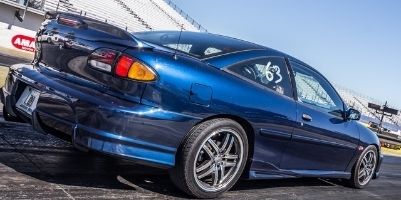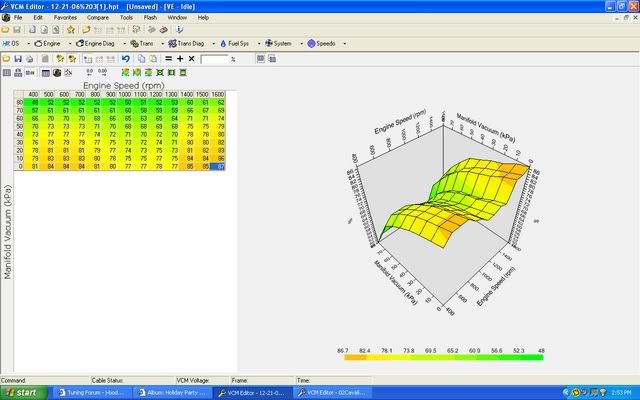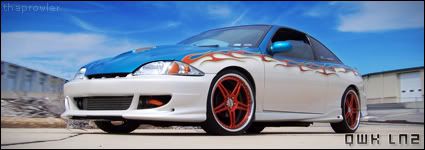First off the car is a 2002 2.4L Ld9 Manual trans with the 2 bar supercharger reflash modified for the turbo setup. For more info on the car please read my profile. I have just put my car back into closed loop for the winter and now whenever I come to a stop or rev the engine a little while not moving the car will bog down and stall. It doesn't do this in open loop at all. I have put both brand new O2 sensors from GM in and that didn't make a difference. I have also changed out the IAC between the three that I have and it does the same thing with all three. I think It is something in my tune causing it to do this.
To read up more on this and view my HPTuners file and Datalogging session go here
HPTuners Forum
I am open to all suggestions on this subject. Thank You in advance
Edited 1 time(s). Last edited Wednesday, December 20, 2006 2:37 PM

ther is a log posted in my thread in HPtuners forum posted above

Why have you changed the tune just for winter?
 FU Tuning
FU Tuning
When it started getting cold out the car runs much richer than it did during the summer. Plus I want to get it running right in closed loop to keep the car emissions legal.

Sorry I had a bit of a brain fart and shuld have asked why was the car not tuned for closed loop? I know you had some dyno time and lots of tuning. This is the first I have heard of switching the car from open loop to closed loop. Actually did not know we could make the car stay in one or the other. I do understand the richness with cooler weather. I would think either having another dyno session for a winter tune (that you could save, and switch back to when needed), or at least do some of your own tuning to lean it out a little.
 FU Tuning
FU Tuning
I don't use HPT so I can't look at the logs or the tune. But I'll give you some tips that I've picked up along the way and maybe they'll help.
Datalogging a stall can be tough. Engine speed is slow, data takes time to get from asensor to the pcm then to the laptop. What you see may not be exactly what's happening. O2 values can be meaningless at the time of stall, but they often tell a story right before a stall.
Quick changes to idle speed are usually caused by timing. Timing affects engine speed quickest. Fuel is next. IAC is last. Stalling is usually not an IAC problem.
All PCM's which I've dealt with have a "stall saver" where a bunch of timing is added, sometimes extra fuel is added, and the IAC is opened. It's the pcm's way of stepping on the throttle. With a non-stock engine the original stall saver settings can cause problems.
Check your IAC counts or steps, if you can see them. I like to see this number around 20-30 at idle, when warm. If it's higher, consider adjusting the throttle stop to open the throttle slightly. If the throttle is closed a little too much it can aggravate stalling.
Check timing tables for bad values. Make sure changes from cell to cell aren't too great. If you've got a whole bunch of "20s" and a "5" in the middle, it can cause a problem. Sometimes I'll adjust the values below the desired engine idle rpm so they are all the same. This eliminates one possible variable.
Make sure the VE tables are smooth, too. No large changes, especially at lower rpm. If a pcm activates stall saver, it will add extra fuel. At the same time this happens, rpm is dropping and MAP will go up. If the low rpm, high MAP portions of the VE table are rich, then this fuel added to the extra fuel from "Stall saver" can be enough to kill the engine.
Do you guys have access to the injector voltage corrections in HPT? These can be a big deal with large injectors. When engine speed drops slightly, alternator output can drop 2-3 volts quickly. Injectors open slower with less voltage, so the pcm will try to hold them open longer. If the corrections are too far from what they should be the engine may quickly go lean or rich.
When an engine is in open loop the feedback process for the fuel correction is ignored. If it's generating wrong info, the pcm doesn't care. But when you enable closed loop the pcm adjust fuel delivery based on the info it gets from the sensor, whether or not it's right. Sometimes you need to adjust fuel trim parameters and system response times to O2 signals. Again, can't tell you which values since I don't have HPT.
BTW, the problem you're dealing with sounds very, very much like what I had to fight with the large injectors in my 2.2 engine. I had hoped you guys with sequential injection wouldn't have the same issues since each injector only fires one time.
Try pushing the brake while the engine is idling. If the engine bogs and tries to stall you may have a problem with acceleration enrichment delivering too much fuel. I know there's no tables for AE adjustment, but the answer may lie in the double fire injection mode tables. I'd make sure both of these tables are matched, however it's done.

Watch your minimum pulsewidth. It's possible to command an injector to be open for less time than it takes to form a proper spray pattern. It's more likely with large injectors. The amount of time will depend on the type of injector, system voltage, flow rate, etc. If you have a scope you can clearly see when this is happening.
The reason the car will run well in open loop is because you're running rich, always. An engien will usually be smoother when slightly rich. What you might try is adjusting the values which limit how much fuel correction can be applied to see just how rich the engine wants to run. You might catch the real problem while you're doing this.
Wish I could give you a more solid answer. Hopefully something here helps.
-->Slow
im having this same problem, ran fine when it was hot out, since cold weather hit its been stalling exactly like the poster, damn i gotta get tuned. im waiting for the spring though so i can get a fresh tune and be sure it wont mess up due to weather changes.

DCstang... when I had your tuned in my car, my car would rev up after each shift, and sometimes idle to 3500rpm for no apparent reason in summer, I since then put my own tune back in and did some dyno time.. try tuning it back to stock, changing only the 100+kpa values.. just a thought
HP Tuners | Garrett T3/T04B | 2.5" Charge Pipes | 2.5" Downpipe | 650 Injectors | HO Manifold | Addco front/rear | Motor Mounts | HKS SSQV | Spec stage 3 | AEM UEGO Wideband | Team Green LSD | FMIC | 2.3 cams | 2.3 oil pump swap | 280WHP | Now ECOTECED

After looking at his tune, the injector constant does not seem right at all, and the Idle VE table looks like the grand canyon.......


P&P Tuning
420.5whp / 359.8wtq
I have used the stock ve table and it does the same thing, so I modified it to make my afr at my wideband right. What should I have my constant at?

another thing... after reflashing my 2000 2.4 sometimes it takes 2 or 3 colds starts for the engine to not die...
HP Tuners | Garrett T3/T04B | 2.5" Charge Pipes | 2.5" Downpipe | 650 Injectors | HO Manifold | Addco front/rear | Motor Mounts | HKS SSQV | Spec stage 3 | AEM UEGO Wideband | Team Green LSD | FMIC | 2.3 cams | 2.3 oil pump swap | 280WHP | Now ECOTECED

Wow... look at that VE table. It's probably fair to say that little has been done below 800 - 900 rpm. Really, how often does the engine run at those low rpm's.
There is probably more than one way to solve this problem. There's been enough times with the J car HPT where the injector constants don't work when the math is applied that I'd search for the reason why. With a correct injector constant, the VE table shouldn't have to be changed too much. But you've done a bunch of work already and it sucks to throw that out and start again. Maybe you can find an answer using the injector constant you've got now.

Look at the VE table. Lines 1, 2, and 3 show how the PCM moves through the cells as you step on the throttle from idle with the trans in neutral. First vacuum decreases and rpm increases. Then vacuum increases sharply when the throttle is snapped closed. Finally the engine speed drops and vacuum stays high, until rpm approaches idle speed and vacuum drops slightly.
Most of the VE cells look fairly reasonable, but there's a potential problem between the 80, 70, and 60 kPa vacuum cells. Notice how you've set up a change of almost 15% VE from 80 kPa to 60? That may be a little too much. Especially where changes between 60, 50, and 40 kPa are around 2-5%. If you're in open loop all that happens is the engine may go lean on decel then come back to normal. You might notice some popping out the intake or a slight hesitation if you do a real strong decel run, maybe hitting 3rd gear at 45-50 and coasting down for a few seconds then stomping on the throttle. But with the engine in closed loop there may be a problem. If Decel Enleanment isn't enabled during the coastdown, (injector PW driven to 0ms) the pcm is likely to try and add fuel if your VE table is too lean while the engine is coasting down. Fuel trims will go up. Then the engine rpm and vacuum get close to normal, and the VE table adds another 10 - 15% more fuel on top of what the fuel trim is adding and suddenly the engine gets rich and begins to bog. Now look at the line labelled "Stall" and see how the problem may get worse. In addition to the fuel change in the VE table plus fuel added by the fuel trims, the pcm moves to cells showing VE to be in the 80% area, adding even more fuel. Dumping fuel that fast can really cause the engine to stall. And finally, if it enters a stall saver mode and increases timing while dumping more fuel, well, you've probably soaked the plugs at this point.
This table is labeled "idle VE" so I'm guessing there's a "main VE" table, too? Is the switch between "idle VE" and "main VE" determined by throttle position? If so you should try to match the VE cells at the point where the pcm switches from one table to the other. If one table calls for more fuel and suddenly the other calls for less then the pcm is stuck playing catch up with fuel trims that are way out of whack. This isn't a good situation. And to make matters worse, if there's a main spark table and an idle spark or closed throttle spark table, those can cause even more of a problem if they aren't close.
-->Slow
Well I have also been having a problem with my cavalier stalling. It ran fine when it was nice out but since its cold it seems to die now and then and sometimes it will try and bounce back up and I can rev it a little to stop it from stalling. I am just running the 2 bar, the 310cc injectors, and the gm reflash. I am running TR6 spark plugs at a .035 gap I believe. It doesn't do it all the time though and seems to only do it when I think about it lol.
~Boost. Its what's for dinner!~













